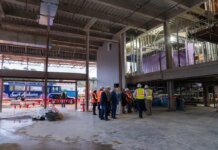
Ben Strout’s story begins, as many a story does, on a dark and stormy night.
“It was pouring down rain, and we had a job that had the roof taken off,” the Birmingham architect says. “We were trying to keep tarps on it, but it wasn’t working. And all the water got in, and we were like, oh, cool, now we get to redo the entire second floor, as well as the first floor. That was a real punch in the pocketbook, and I thought, there’s got to be a way to do this where we’re not going to ruin everything on the main level.”
But there wasn’t, at least as far as Strout could tell, so he developed his own system involving beams, bolts and a proprietary patent-pending bracket called “The Householder.” It allows builders to construct the added story on top of the existing roof, which is removed only after the new story above it is complete.
That system is at the core of AnotherStory, the company founded by Strout in 2021. Prior to that, Strout was a partner at Appleseed Workshop, established in 2006, but left in 2015 to start his own firm, Strout Architecture and Construction. The system was developed through years of experience in the field, including his time at Appleseed Workshop.

Joshua Dean also was a co-founder at Appleseed, and now he’s president of Precision Homecrafters, the only builder licensed to use Strout’s process right now. He’s also the No. 1 proponent of Strout’s process.
“People were always asking the wrong question,” says Dean, who is past president of the Greater Birmingham Association of Home Builders. “The question was always how do you take the roof off a house and put it back as quickly as possible? Ben’s question was how do you not take the roof off? In a perfect world, there would never be a day that a roof isn’t over the house.”
Dean says one of the biggest pluses of Strout’s system is that clients don’t have to move out of their homes for the bulk of construction. In some cases, they move out at the end when stairs are being built to connect to the original level, but in other cases, they don’t have to leave at all.
“That’s one of the biggest issues, the displacement issue,” Dean says of the standard way of building second stories. “They have to move out, get some storage units or pods, find a place to live for six months to a year. But by doing it this way, they literally can live at the site the entire time. Everything’s going on above them, and the second floor is a separate structure from the house. The benefit to the homeowner is significant.”
Jon Gray, who lives in Homewood, can attest to that.
After the birth of their third child, Gray and his wife, Anna, knew that they needed to add to their three-bedroom, two-bathroom house.
“We knew we needed to build out or build up,” he says. “Building out meant tearing up our yard, which we didn’t want to do, so we planned to build up.”
That brought its own challenges, including budgeting to live outside of their house for almost a year. But a close neighbor and general contractor took care of that when he suggested Gray contact Dean.
“Josh said, ‘There’s this guy named Ben Strout,’” Gray recalls. “’He has this system where you can actually stay in the house.’”
About eight months later, the Grays had added a second story, with three new bedrooms and two new bathrooms, and they never moved out of their house during construction.
“Not one day,” he says. “We were there the whole time.”
What’s more, the process survived some nasty Alabama thunderstorms.
“There was one huge, crazy storm while they were putting the roof up,” Gray recalls. “Not a drop of water got in the house. And they were able to work during the rain.”
Soon after adding the second story, the Grays moved into it while Precision Homecrafters remodeled their master suite downstairs.

Strout and Dean say the process also is more convenient for builders.
“Timeline-wise, it’s not different from your standard second-story addition process, but there’s no massive crunch,” Strout says, adding that in the standard process, “There’s always a massive crunch to frame this thing as quickly as possible to minimize risk.”
Dean says the AnotherStory process offers his builders the best of two worlds.
“My whole company is built on going into people’s homes and doing extensive remodeling projects, and we get the best of the remodeling world and the construction world by doing it this way,” he says. “We have a new construction site, even though it’s a remodeling project.”
Dean says the process will become even more necessary in the coming years, which he forecasts will see a slow-down in new housing and extra demand for remodeling and adding more room to existing homes.
“People are going to need to have other options to meet their family’s needs,” Dean says. “We can let you stay right where you are.”
Strout is hoping to eventually take his AnotherStory process nationwide, and an addition using Strout’s process is a finalist for a National Association of Home Builders award.
“The only issue we have right now is we don’t have enough social proof,” says Strout, who says four houses have been remodeled using his approach. “We need more validation from people. We have testimonials, but we need more. It’s such a big thing we’re doing, and nobody wants to be a guinea pig.”
Gray, the Homewood homeowner, however, was pleased to be a guinea pig, saying the system Strout developed really is a no-brainer.
“Once he describes it, you wonder, why haven’t I thought about this?,” he says with a laugh. “I wish I could invest in his company.”

Dean calls Strout’s process, which has a patent pending, a “phenomenal idea.”
“The fact that nobody else has come up with this so far is crazy to me,” he says. “I can’t imagine people doing this the old way. … I think this is the revolution of the renovation industry. I don’t think that’s an overstatement.”
Alec Harvey is executive editor of Business Alabama and Art Meripol is a freelance contributor. Both are based in Birmingham.
This article appears in the February 2023 issue of Business Alabama.



